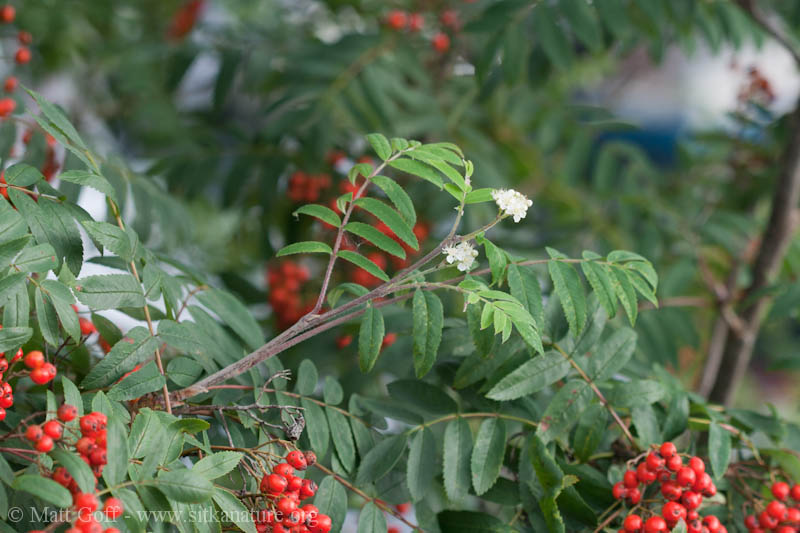Late season flowers on a European Mountain Ash (Sorbus aucuparia).
While walking home one day last week, I noticed some light-green new looking growth on a Mt. Ash (Sorbus aucuparia) along the Lincoln Street green belt adjacent to Crescent Harbor. A little further along, I noticed a tree that had a few flowers. This struck me as a bit odd, since I’ve been noticing how much it already seems like fall is coming on. The temperatures haven’t really dropped yet, but the leaves are starting to, and most of the flowers are long gone.
This year I have been trying to pay more attention to blooming times, and something that has been interesting to me lately is how few things seem to be blooming even though it will be a fair while yet before we are likely to have a good freeze. The plants that are still blooming seem to fall into three categories. There are the species that don’t start blooming until late summer, there are plants with an extended blooming period, and finally the plants that seem to putting out a second, much less abundant, set of blooms well after the primary blooming period has ended.
There are only a few species that I associate with a late summer primary blooming period including Kneeling Angelica (Angelica genuflexa) and Douglas Aster (Symphiotrichum subspicatum), Rattlebox (Rhinanthus minor), and the introduced Hairy Cat’s Ears (Hypochaeris radicata).
Species with a blooming period that has a long tail include, Fireweed (Chamerion angustifolium), Foxglove (Digitalis purpurea), Yarrow (Achillea millefolium), Cleavers (Galium aparine), Pacific Water-Parsley (Conioselinum gmelinii), and the introduced (and invasive) Spreading Buttercup (Ranunculus repens), and Common Ragwort (Senecio vulgaris). This last deserves special mention, as last fall I noticed it blooming until at least the second week of November, and the first plant I saw blooming this spring was in March (though it was May before I started noticing in commonly).
Finally, the group of species that are blooming well after their primary blooming period include Dandelion (Taraxacum officianale), European Mountain Ash (Sorbus aucuparia), and in other years I’ve also seen Giant Vetch (Vicia nigricans ssp. gigantea), and . This group seems to consist of two sub-groups, those plants that consistently do it and those where the blooming seems to be more accidental. The vetch and mountain ash definitely seem to be in the latter category, though I am not sure what might cause such an accidental flowering to occur. Dandelions (and probably the miner’s lettuce, though I’ve not noticed it specifically) do seem to have a late season push of flowers, though not nearly as abundant as in the early summer primary blooming period.
Late season new growth on a European Mountain Ash (Sorbus aucuparia).


I have a great interest in Dandelions which has just sprouted this year- did you know you can make jelly out of the petals?! It tastes quite pleasant (in my opinion anyhow) They seemed to bloom most of the spring/summer, with only a few week period where they had seeded then came back…
Recipe:
http://sitkakoala.blogspot.com/2010/05/dandelion-delight.html
Thanks for the comment. I noticed a few scattered dandelions blooming throughout the summer, but it seems like the big abundance was in late April and May. Not that they are especially hard to find generally, but the rocky/gravel slope from O’Connell Bridge down to the water (on the town side) was absolutely covered in dandelions blooming. I thought I took a picture of it, but haven’t been able to find it.